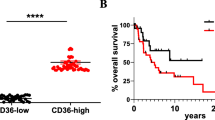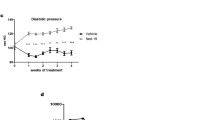Abstract
Glomeruloid microvascular proliferations (GMPs), which are focal proliferative buddings of endothelial cells resembling a renal glomerulus, can be induced experimentally by adenoviral transfer of VEGF-A165. We recently found that GMPs were present in 13–23% of various human tumours (melanoma, breast-, endometrial- and prostate cancer), and this vascular signature was significantly associated with an impaired prognosis. In the present study, a series of 202 vertical growth phase melanomas were examined for the expression of various angiogenic factors and their receptors. Presence of GMP was associated with increased expression in tumour endothelium of the VEGF-A receptors KDR, FLT-1 and neuropilin-1, as well as VEGF-D protein. Thrombospondin-1 staining in the tumour stroma showed the same relationship. Endothelial cell expression of VEGF-A was increased in GMP endothelium when compared with other intra-tumoural vessels. In contrast, GMP expression of bFGF was decreased. Our findings suggest an important role of VEGF-A and its receptors in GMP formation in human cutaneous melanoma.
Similar content being viewed by others
References
Folkman J. Tumor angiogenesis: Therapeutic implications. N Engl J Med 1971; 285: 1182–6.
Burke PA, DeNardo SJ. Antiangiogenic agents and their promising potential in combined therapy. Crit Rev Oncol Hematol 2001; 39: 155–71.
Gasparini G. Clinical significance of determination of surrogate markers of angiogenesis in breast cancer. Crit Rev Oncol Hematol 2001; 37: 97–114.
Rofstad EK, Halsor EF. Vascular endothelial growth factor, interleukin 8, platelet-derived endothelial cell growth factor, and basic fibroblast growth factor promote angiogenesis and metastasis in human melanoma xenografts. Cancer Res 2000; 60: 4932–8.
Neufeld G, Cohen T, Gengrinovitch S, Poltorak Z. Vascular endothelial growth factor (VEGF) and its receptors. FASEB J 1999; 13: 9–22.
Fidler IJ. Angiogenesis and cancer metastasis. Cancer J Sci Am 2000; 6: S134–41.
Weidner N, Semple JP, Welch WR, Folkman J. Tumor angiogenesis and metastasis-correlation in invasive breast carcinoma. N Engl J Med 1991; 324: 1–8.
Weidner N. Tumoural vascularity as a prognostic factor in cancer: The evidence continues to grow. J Pathol 1998; 184: 119–22.
Hlatky L, Hahnfeldt P, Folkman J. Clinical application of antiangiogenic therapy: Microvessel density, what it does and doesn't tell us. J Natl Cancer Inst 2002; 94: 883–93.
Pettersson A, Nagy JA, Brown LF et al. Heterogeneity of the angiogenic response induced in different normal adult tissues by vascular permeability factor/vascular endothelial growth factor. Lab Invest 2000; 80: 99–115.
Wesseling P, Vandersteenhoven JJ, Downey BT et al. Cellular components of microvascular proliferation in human glial and metastatic brain neoplasms. A light microscopic and immunohistochemical study of formalin-fixed, routinely processed material. Acta Neuropathol 1993; 85: 508–14.
Brat DJ, Castellano-Sanchez A, Kaur B, Van Meir EG. Genetic and biologic progression in astrocytomas and their relation to angiogenic dysregulation. Adv Anat Pathol 2002; 9: 24–36.
Schiffer D, Bosone I, Dutto A et al. The prognostic role of vessel productive changes and vessel density in oligodendroglioma. J Neurooncol 1999; 44: 99–107.
Sundberg C, Nagy JA, Brown LF et al. Glomeruloid microvascular proliferation follows adenoviral vascular permeability factor/vascular endothelial growth factor-164 gene delivery. Am J Pathol 2001; 158: 1145–60.
Straume O, Chappuis PO, Salvesen HB et al. Prognostic importance of glomeruloid microvascular proliferation indicates an aggressive angiogenic phenotype in human cancers. Cancer Res 2002; 62: 6808–11.
Tanaka F, Oyanagi H, Takenaka K et al. Glomeruloid microvascular proliferation is superior to intratumoral microvessel density as a prognostic marker in non-small cell lung cancer. Cancer Res 2003; 63: 6791–4.
Straume O, Akslen LA. Expression of vascular endothelial growth factor, its receptors (flt-1, kdr) and tsp-1 related to microvessel density and patient outcome in vertical growth phase melanomas. Am J Pathol 2001; 159: 223–35.
Elder DE, Murphy GF. Melanocytic tumors of the skin. In Rosai J, Sobin LH, (eds): Atlas of Tumor Pathology. Washington, DC: AFIP 1991; 119–131.
Straume O, Akslen LA. Importance of vascular phenotype by basic fibroblast growth factor, and influence of the angiogenic factors basic fibroblast growth factor/fibroblast growth factor receptor-1 and ephrin-A1/EphA2 on melanoma progression. Am J Pathol 2002; 160: 1009–19.
Straume O, Akslen LA. Alterations and prognostic significance of p16 and p53 protein expression in subgroups of cutaneous melanoma. Int J Cancer 1997; 74: 535–9.
Rojiani AM, Dorovini-Zis K. Glomeruloid vascular structures in glioblastoma multiforme: An immunohistochemical and ultrastructural study. J Neurosurg 1996; 85: 1078–84.
Goffin JR, Straume O, Chappuis PO et al. Glomeruloid microvascular proliferation is associated with p53 expression, germline BRCA1 mutations and an adverse outcome following breast cancer. Br J Cancer 2003; 89: 1031–4.
Soker S, Takashima S, Miao HQ et al. Neuropilin-1 is expressed by endothelial and tumor cells as an isoform-specific receptor for vascular endothelial growth factor. Cell 1998; 92: 735–45.
Whitaker GB, Limberg BJ, Rosenbaum JS. Vascular endothelial growth factor receptor-2 and neuropilin-1 form a receptor complex that is responsible for the differential signaling potency of VEGF(165) and VEGF(121). J Biol Chem 2001; 276: 25520–31.
Lee P, Goishi K, Davidson AJ et al. Neuropilin-1 is required for vascular development and is a mediator of VEGF-dependent angiogenesis in zebrafish. Proc Natl Acad Sci USA 2002; 99: 10470–5.
Sundberg C, Kowanetz M, Brown LF et al. Stable expression of angiopoietin-1 and other markers by cultured pericytes: Phenotypic similarities to a subpopulation of cells in maturing vessels during later stages of angiogenesis in vivo. Lab Invest 2002; 82: 387–401.
Folkman J, Shing Y. Angiogenesis. J Biol Chem 1992; 267: 10931–4.
Brown LF, Guidi AJ, Schnitt SJ et al. Vascular stroma formation in carcinoma in situ, invasive carcinoma, and metastatic carcinoma of the breast. Clin Cancer Res 1999; 5: 1041–56.
Good DJ, Polverini PJ, Rastinejad F et al. A tumor suppressordependent inhibitor of angiogenesis is immunologically and functionally indistinguishable from a fragment of thrombospondin. Proc Natl Acad Sci USA 1990; 87: 6624–8.
Tolsma SS, Volpert OV, Good DJ et al. Peptides derived from two separate domains of the matrix protein thrombospondin-1 have anti-angiogenic activity. J Cell Biol 1993; 122: 497–511.
Streit M, Velasco P, Brown LF et al. Overexpression of thrombospondin-1 decreases angiogenesis and inhibits the growth of human cutaneous squamous cell carcinomas. Am J Pathol 1999; 155: 441–52.
Taraboletti G, Morbidelli L, Donnini S et al. The heparin binding 25 kDa fragment of thrombospondin-1 promotes angiogenesis and modulates gelatinase and TIMP-2 production in endothelial cells [in process citation]. FASEB J 2000; 14: 1674–6.
Chandrasekaran L, He CZ, Al-Barazi H et al. Cell contactdependent activation of α3β1 integrin modulates endothelial cell responses to thrombospondin-1 [in process citation]. Mol Biol Cell 2000; 11: 2885–900.
Van Belle PA, Elenitsas R, Satyamoorthy K et al. Progressionrelated expression of beta3 integrin in melanomas and nevi. Hum Pathol 1999; 30: 562–7.
Tuszynski GP, Nicosia RF. Localization of thrombospondin and its cysteine-serine-valine-threonine-cysteine-glycine-specific receptor in human breast carcinoma. Lab Invest 1994; 70: 228–33.
DiPietro LA. Thrombospondin as a regulator of angiogenesis. Exs 1997; 79: 295–314.
Hayes AJ, Huang WQ, Yu J et al. Expression and function of angiopoietin-1 in breast cancer. Br J Cancer 2000; 83: 1154–60.
Kloth S, Gerdes J, Wanke C, Minuth WW. Basic fibroblast growth factor is a morphogenic modulator in kidney vessel development. Kidney Int 1998; 53: 970–8.
Hawighorst T, Skobe M, Streit M et al. Activation of the tie2 receptor by angiopoietin-1 enhances tumor vessel maturation and impairs squamous cell carcinoma growth. Am J Pathol 2002; 160: 1381–92.
Stoeltzing O, Ahmad SA, Liu W et al. Angiopoietin-1 inhibits vascular permeability, angiogenesis, and growth of hepatic colon cancer tumors. Cancer Res 2003; 63: 3370–7.
Author information
Authors and Affiliations
Corresponding author
Rights and permissions
About this article
Cite this article
Straume, O., Akslen, L.A. Increased Expression of VEGF-Receptors (FLT-1, KDR, NRP-1) and Thrombospondin-1 is Associated with Glomeruloid Microvascular Proliferation, an Aggressive Angiogenic Phenotype, in Malignant Melanoma. Angiogenesis 6, 295–301 (2003). https://doi.org/10.1023/B:AGEN.0000029408.08638.aa
Issue Date:
DOI: https://doi.org/10.1023/B:AGEN.0000029408.08638.aa




